Email marketing ideas — three steps to unlock your next campaign
Email marketing campaigns are a fundamental part of growing any business or organization. It usually has the best ROI of any marketing channel, but depends on consistency — staying in touch with your subscribers regularly, not sporadically. But continually coming up with new content to share can drain your time and brainpower. Thankfully, we’re here to help you with generating new email marketing ideas so that you’re inspired and can fill up your queue.
A consistent, steady flow of emails is key to keeping people engaged and subscribed. It helps you remain top of mind.
So if you’re here because you feel like you’ve run out of email marketing ideas — or you just want to boost your planning for the upcoming months — you’ve come to the right place.
You’re about to learn a three-step process for developing and implementing new email campaign ideas that will keep your subscribers happy and sustain your marketing efforts. When you’re done with this article, you’ll know how to tap into an endless supply of email ideas and increase engagement with proven email marketing tips.
Sound good? Let’s roll.
A three-step process for kickstarting new email marketing ideas
↑ Torna in cimaPart of the reason people struggle with ideas is lack of clarity around what they actually need. It’s hard to start writing a novel if you don’t have a plot in mind.
So the three-step process to developing new email marketing campaign ideas is all about defining the purpose and tactics behind your campaign. The three steps are:
- Choose a business goal or objective to prioritize
- Select the marketing tactics you’ll use to pursue that goal
- Outline the types of emails that will help you fulfill the marketing tactics
Once you’ve gone through the process above, you’ll have a much clearer picture of the emails you need to create and some inspiration for at least a few ecommerce email marketing ideas. It’s not a guarantee that you’ll overcome your email marketing writer’s block, but it’ll get you most of the way there.
Email marketing campaign goals
↑ Torna in cimaThe first step to generating marketing ideas for email campaigns is to figure out what you want to accomplish. Here are some business objectives, needs, priorities, and goals you might want to focus on:
More revenue
For most organizations, more money is a never-ending goal. This is the most broad (and common) mission, and there are many different ways to achieve it.
More engagement
One of the keys to long-term success is an engaged, active subscriber base. More opens and a higher click through rate mean your subscribers and potential customers are responding to your email content. Your message is getting through, you’re meeting needs, and you’re relevant in their lives.
If you feel like your open and click-through rates are slipping, or if you just haven’t done an engagement-focused campaign in a while, this might be the focal point of your next great email series.

More repeat buyers
Customers are good. Repeat customers are better. Another great business goal would be to create an email campaign targeting your existing customers, or perhaps just your first-time customers. The idea would be to motivate some of these people to make a second or third purchase.
The more someone shops with you, the more brand loyalty they develop, because people gravitate towards the companies they’re most familiar with.
More new customers
The complementary approach to the previous idea would be to create a campaign that targets all your new subscribers who have not yet made a purchase. These are people who have opted in to receive your emails, but for whatever reason, haven’t bought anything yet.
You can create an email campaign designed to motivate that all-important first purchase. This is the ultimate goal of lead generation marketing — to turn leads into paying customers. Your email contact list is filled with unconverted leads. When was the last time you created a campaign for this specific target audience?
Fewer unsubscribes
A more engaged subscriber is less likely to unsubscribe. If you’ve noticed your unsubscribe rate creeping up in recent months, maybe it’s time to try a fresh approach to re-capture the attention and interest of your subscribers.
Better membership retention
If you have any kind of monthly or annual membership, club, or other source of recurring revenue, you have to continually re-sell its value so that fewer customers leave the program.
Yes, you want new members too — and that could be another campaign focus — but you also want your existing members to renew and keep renewing. How do you do that? By sending a steady stream of email content that positions you as an essential part of their lives.
Unique goals for your company
There are six business goals listed above. You might choose one of those or you might find something else to focus on. Consider the various segments of your email list and your business as a whole. Focusing on any one of those segments can reveal the business priority you want to address in your next email campaign.
So find an audience segment you want to connect more deeply with or a business goal you want to achieve, and you’re on your way to new email marketing ideas.
Marketing tactics to fulfill your campaign goals
↑ Torna in cimaOnce you’ve settled on the goal you want to pursue, the next step is to choose the marketing strategies that you’ll use to pursue that goal. There are endless possibilities, but here are a few to get you started:
Go directly for the sale
You don’t always need a clever strategy to be effective in meeting your goals. Sometimes, a straightforward sales push will do just fine.
You can use incentives like volume discounts, free gifts with purchase, or upgrades to higher levels of membership. Or you could run a traditional discount sale or seasonal promotion.
This all depends on the segment of your email list you’ll be targeting, and the goal of your campaign.
It’s okay to simply push out some benefits or features of your product asking subscribers to take immediate action. This kind of no-nonsense messaging can actually stand out in an inbox where everyone’s trying to outdo each other with creativity. The occasional simple email can be a good way to mix it up and boost sales.
Let’s say your goal is to gain new members to your online fitness program. You could use purchase history data to create a segment of customers who have made at least two purchases. Then, send them a special offer that includes their first month of membership as a free bonus.
The example below is little more than the name and picture of the product they’re selling, a quick call to action, and a button. However, it’s an easy touchpoint to push out to subscribers and won’t weigh readers down with tons of text or information to parse. Clarity like this might actually command an above-average open rate.
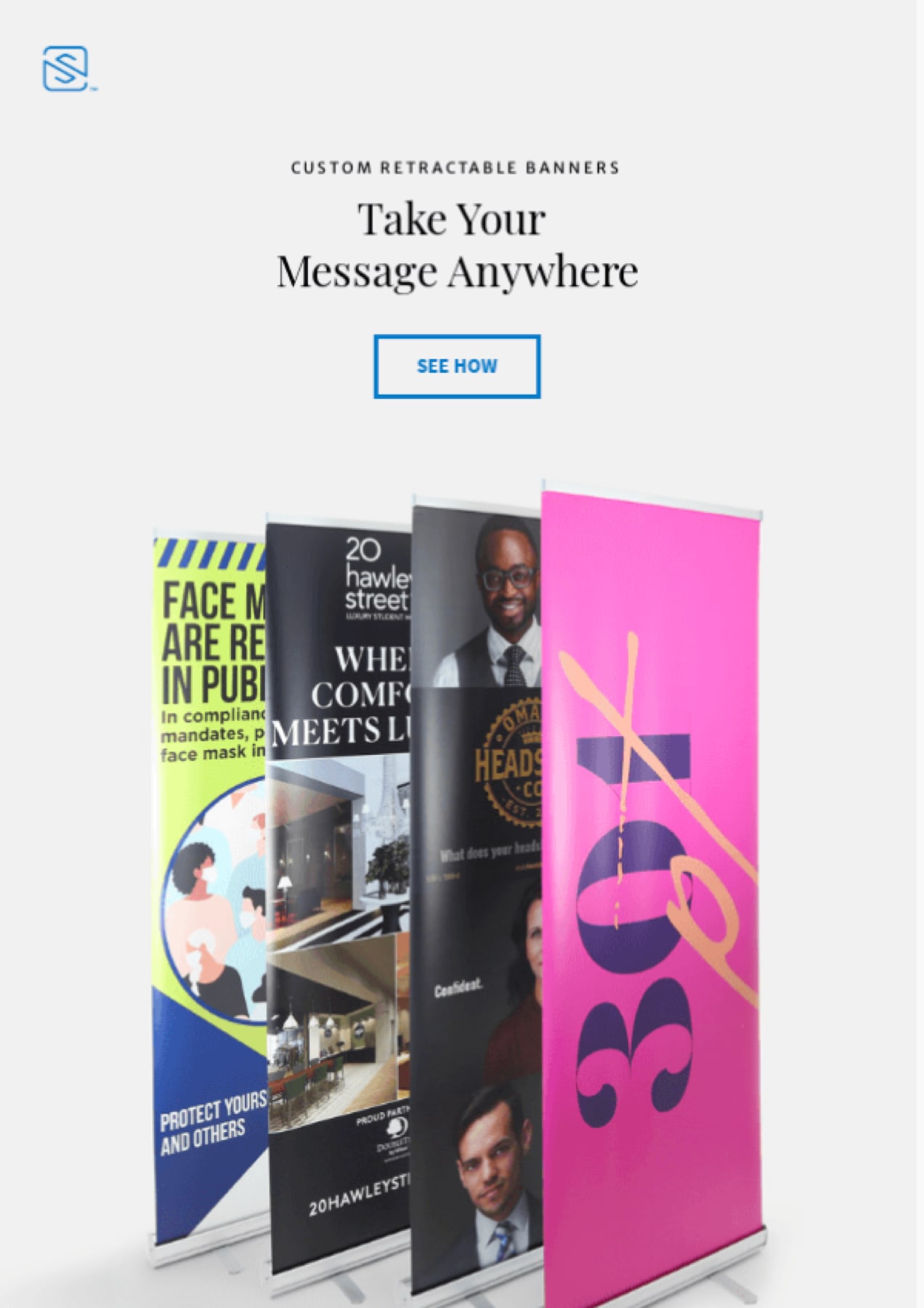
Deliver value
The concept of value is dependent on your specific target audience, along with the products or services you sell. But regardless, delivering value means that you’re giving subscribers content that means something to them rather than just trying to sell, sell, sell.
This could be content that solves a common problem your customers deal with. And that content could come in the form of text, downloadable content, a how-to guide, a video, an infographic, etc.
Here are some more examples of value you could offer for free:
- Ebooks
- Experiences like interactive games, quizzes, or polls
- Contests
- Opportunities to express opinions or give feedback
- Testimonials and customer success stories
- A downloadable template
- Case studies
- White papers
- Ideas for how to best use your products
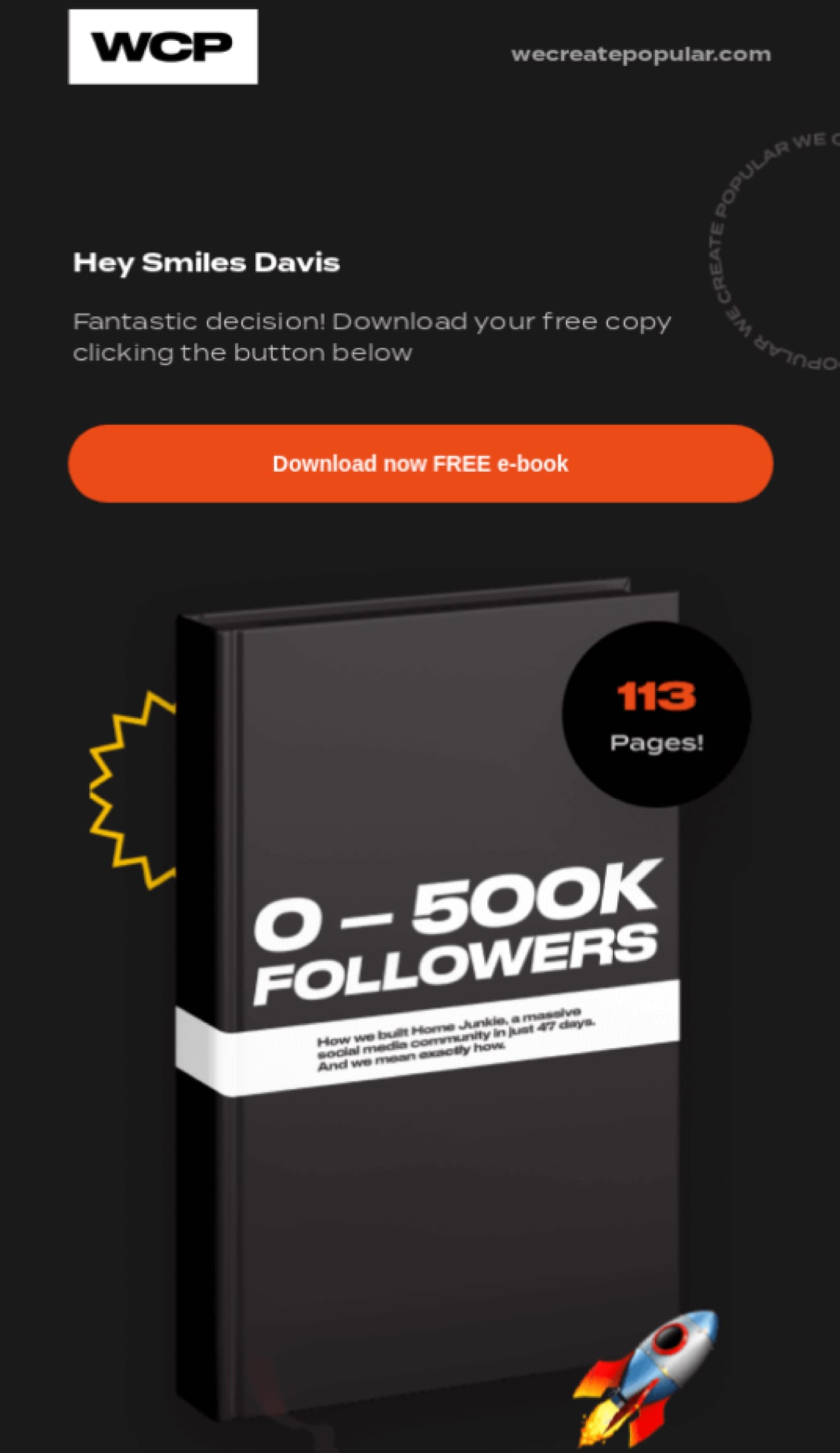
This email from we create popular gets straight to the point and immediately communicates the offer — an ebook with a compelling promise.
Valuable content generates engagement. If increased engagement is one of your goals from step one, this is likely the best tactic to use.
Generate excitement
Another strategy that increases both engagement and sales is to generate excitement. When you work to create emotions like joy, surprise, or laughter, subscribers will bond to you more deeply.
Sometimes, generating this excitement simply requires you to get excited yourself. You can use special fonts, colors, and language to tell subscribers how excited your brand is for whatever you’re promoting. Use emojis in your subject lines (sparingly). Pull out the exclamation points.
To bolster your efforts, you could create a countdown or special reveal or even share the progress towards a goal (“We met 90% of our annual fundraising goal in record time! Be a part of history and help us get over the top before Friday!”).
Share a trove of social media posts where other people are excited. Share a GIF that exudes excitement.

No matter how you do it, generating excitement leads to more engagement and subscriber action.
Run a contest
Speaking of excitement, contests are a great way to build this emotion. The more exciting the prize, the more energy the contest will produce. Here are a few contest prize ideas:
- Trips
- Free passes to experiences like concerts, sports events, and museums
- Opportunities to hear speakers your audience would be interested in
- Prizes for the whole family, like a free gourmet dinner
- Earned prizes, like being the first business owner to reach a milestone
- Puzzles and games, especially ones that involve your products, services, or content, such as an online scavenger hunt or trivia contest
When you do a little brainstorming, you can come up with a bunch of great contest ideas, and they don’t have to cost thousands of dollars.
Here’s a simple contest put out by Taco Bell where participants got to vote on the college student section with the best school spirit. Prizes included free tacos. Again, the idea here is participation, interaction, and fun, along with a low-cost prize.
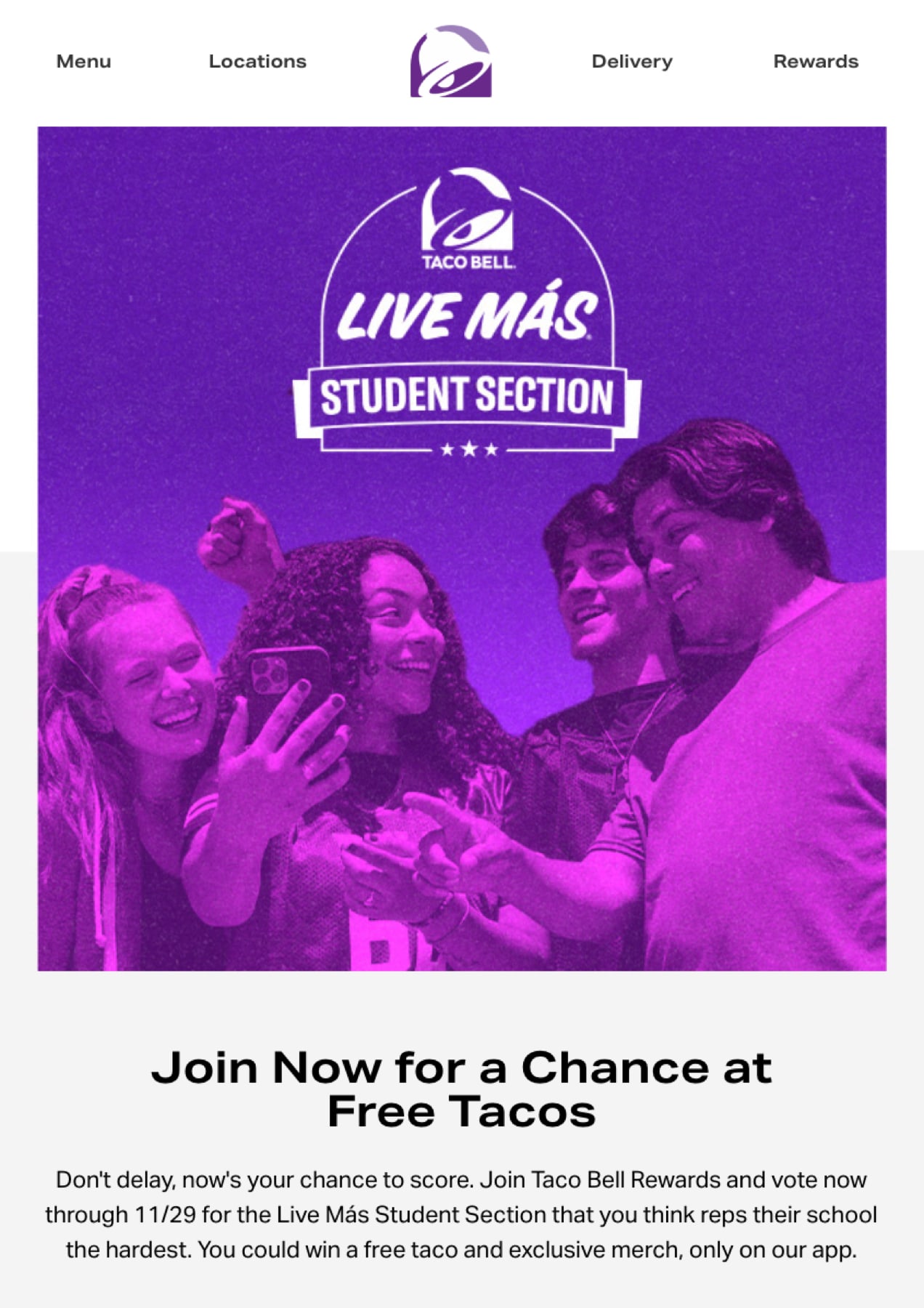
Involve a celebrity
Another way to generate excitement is to involve a celebrity in some way. This could mean a chance to meet the celebrity in person, get a selfie with them, or get an autograph as part of a product sale or giveaway related to your larger marketing campaign.
You can also use celebrities virtually, such as delivering a special presentation or being part of a social media campaign.

Remember, not all celebrities are movie stars and singers. Think beyond that. In your industry, there are probably celebrities your audience adores, but who the outside world has never heard of. A celebrity could be a podcaster, an author, a speaker, a local personality, or a business owner more famous than you.
Incorporate tension, suspense, and anticipation
Any strategy you can come up with that produces any or all of these emotions will generate excitement.
This could be a new product release that you build up with a big email marketing campaign. It could mean the launch of a new tier of services or a software upgrade.
Here’s an effective, internationally-relevant email example with a countdown:

The thrill of winning, having a new experience, or feeling special in some way can be achieved by anything that has a specific date attached to it.
Build community or exclusivity
When subscribers and customers feel like they’re part of something special, they become more loyal and passionate about keeping you in their lives. Plus, they talk about you more, which results in referrals and new revenue.
You can build effective email marketing campaigns designed specifically to create and enrich the feeling of community and exclusivity among your customers.
This might look like some sort of VIP club for anyone who buys a certain item, signs up for a particular reward, or reserves their spot for an event or upcoming new product release.
You can manage this more simply through memberships and rewards programs.
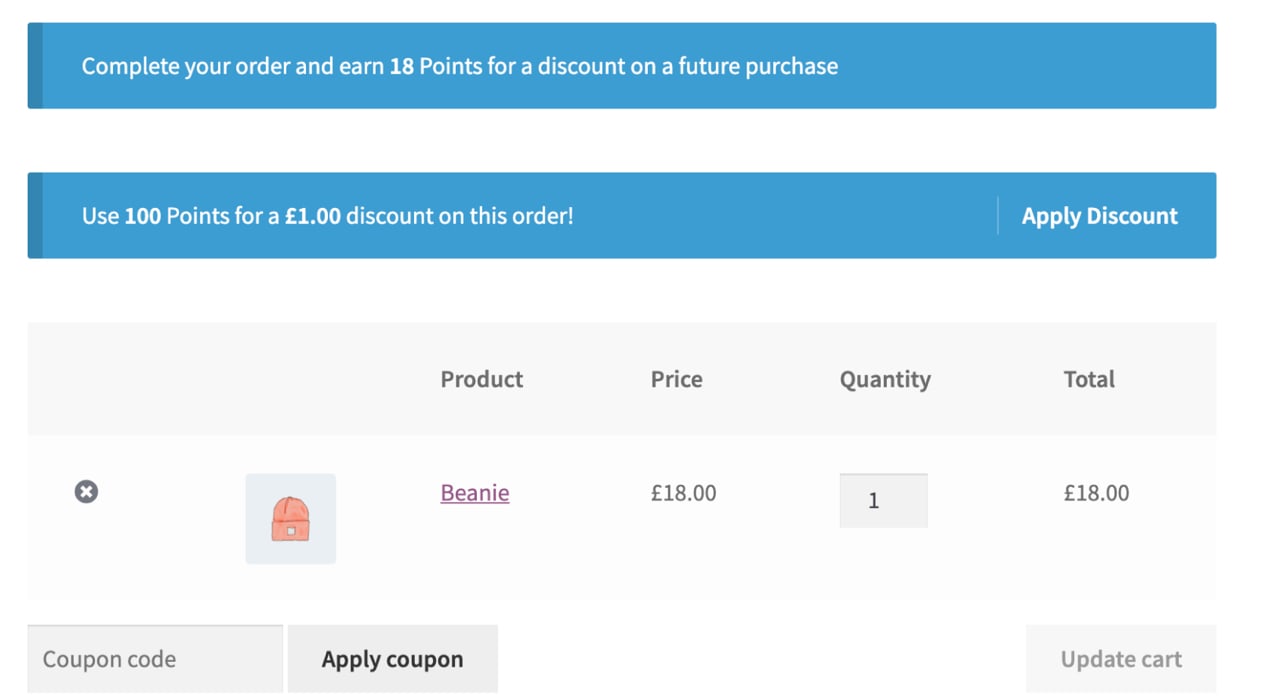
Make sure you’re creating plenty of content for members, and content that’s about more than just perks and deals. What will make members feel like they’re part of something special?
Types of marketing emails to send
↑ Torna in cimaLet’s recap where we are in the three-step process.
First, you chose the goal or objective for your email campaign.
Then you decided on the tactic(s) to pursue that goal. You may end up using more than one of these and that’s okay. In fact, it’s often a good idea to use more than one tactic to accomplish a big goal.
Now, with your goals and tactics in mind, you can start to decide on the kinds of emails you want to send.
There are various types of marketing emails you can create as you implement your strategy. We’ve broken them into three categories — nurturing emails, promotional emails, and automated emails. It’s not a totally-exhaustive list, here are some of the types of emails you should consider using:
Nurturing email ideas
Nurturing emails are used when the primary goal is non-monetary. That doesn’t necessarily mean there’s nothing to buy, but it shouldn’t be the point of the message.
Your goal here is to simply advance subscribers along the customer journey and towards the finish line, stay on the minds of prospects and potential buyers, or encourage or empower previous or existing customers with information that reinforces the value they’re enjoying. Here are a few types of nurturing emails:
Educational emails
B2B audiences want to see anything you can create that helps them do their jobs better and run their businesses more productively, more profitably, more efficiently, and with less stress.
If you’re focusing on consumer audiences, what sorts of things do they wish they could do better, faster, or easier? What do your subscribers and customers worry about? What matters to them?
You’re the expert here, so when you share that expertise with people who have signed up to hear from you, they’ll appreciate it.
And educational emails can take a variety of forms.
Use visuals to make your content more engaging and easier to understand. Or write blog posts on your website and promote them via email. This makes for a short, informational email, and will engage anyone who finds the topic of that post relevant and useful.
This email from Parsley Health provides great advice for gut health and gently pushes a product they sell. But there’s real educational value here and it provides a much softer touchpoint than a promotional email pushing a 20% off sale.
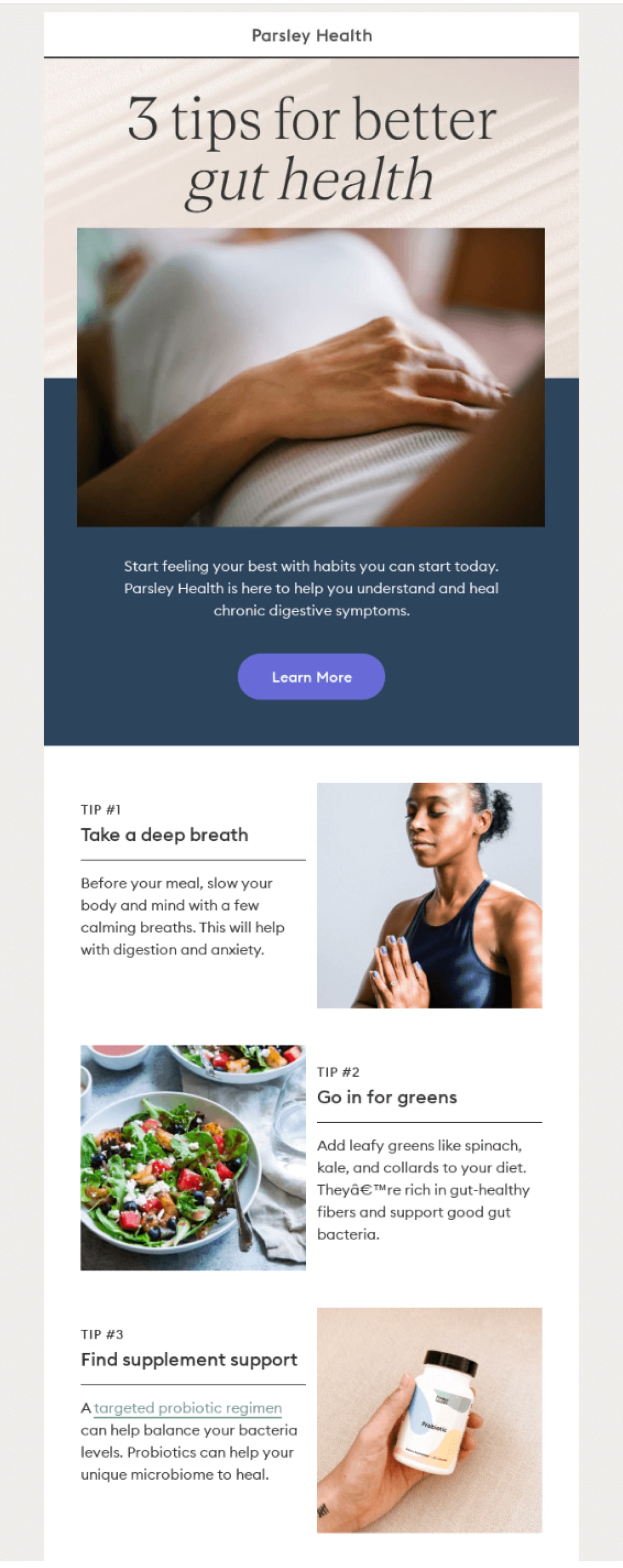
Story and personality emails
You won’t believe what I saw in the news last week…
Isn’t that a great opening sentence for an email? Yes, email subject lines and pre header text get all the attention. But actual email engagement requires more than a good subject line. You also need a great opening for your email campaigns.
And using a story-based approach — especially stories infused with personality — is a great way to increase engagement with your email marketing campaigns.
As the above example demonstrates, you can tell stories about almost anything. Something you saw or read online or in the news. Something that happened while shopping. Something that happened while your family was having dinner. Something your kid told you their teacher said. Something you saw while driving to work. Something you saw on TV. A pop culture story. A sports story. An inspiring story. A historical story.
The point of telling stories like these isn’t just to entertain. The main point is to tie the story into some kind of belief, set of values, or principle that relates to your online business or blog.
For example:
Last week, I went out shopping for a last-minute birthday gift for my daughter. At one store, the cashier not only didn’t look at me once, he didn’t even talk. Other than the sounds of my credit card getting approved and the bag rustling as he put my purchases in it, the entire transaction happened in total silence.
Then, I went to another store, and the cashier was friendly, commented about the great deal I was getting, and thanked me for my business. I left with a literal spring to my step and smile on my face.
My hope is that, when you interact with our customer service team, you feel like I felt at the second store.
If not, please reply to this email and let us know what we can do better.
Sincerely committed to a human-centric world,
Jane Doe
CEO of The Great Example Co.
That’s a simple example, but do you see how a relatable story, punctuated with a little emotion and fun language, can easily be used to also make a point about something relevant to your customers?
These types of emails make your company seem more human. You become more real to them, more trustworthy, and more than just another company sending marketing emails.
Personality-driven stories and anecdotes are a terrific way to actually communicate such that the audience remembers what you said and enjoys reading it. You’re giving them a good experience, not just “content.”
And next time you send an email trying to sell them something, they won’t mind as much. But you need to do this consistently. Not just once and then never again. Stories and personality-driven emails should be a regular part of your email marketing strategy.
These sorts of emails can work well as plain text emails, so you can save some effort on email
design. You can also have more fun with your email subject lines with personality emails.
Here’s an email from Girls Can Crate, sent out on Small Business Saturday, which comes right after Black Friday. This email has more copy than some of the others we’re featuring, which is what you expect from a story or personality-driven email.
The design layout has a few flaws, but that almost adds to the authenticity of the message. You can feel the voice of the writer, and the humanity and sincerity in the message, as well as the personality.
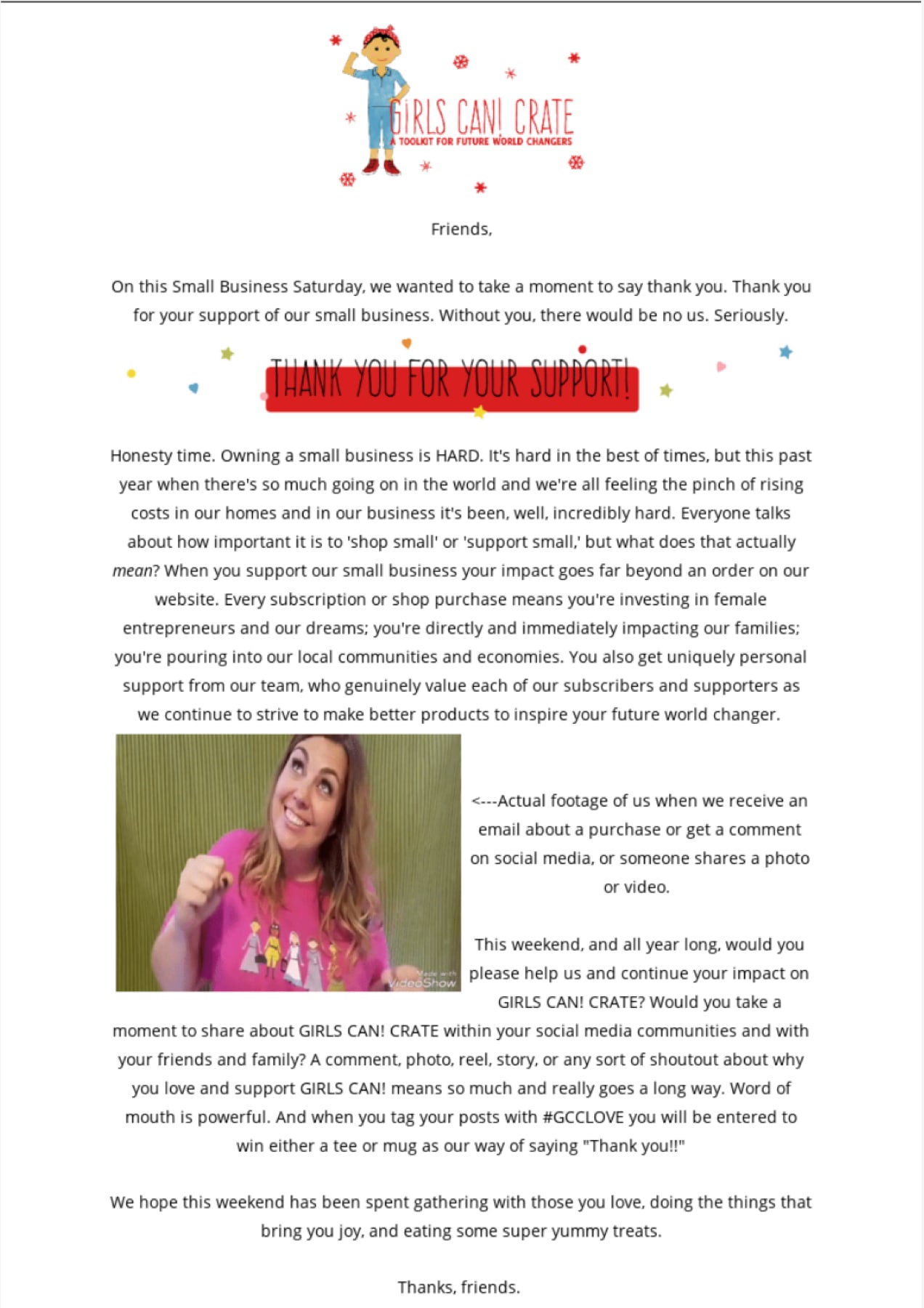
Social proof emails
Social proof email campaigns allow you to:
- Build community by showing customers that there are other people like them
- Reinforce your value proposition
- Let someone other than you do the selling
- Give your subscribers something to share
- Break down objections
- Entice customers to leave reviews
- Increase sales
- Take tasks off your to-do list, since most of the writing is already done for you
People buy because of good reviews. Customer stories and social proof work the same way.
There are several ways to use social proof in an email:
- Case studies. These are longer stories showing how your product or service solved a major problem.
- Testimonials. These are quick stories saying why a customer loves your product.
- Screenshots of online reviews. You can gather these from social media, Google reviews, or similar accounts — just check the terms and conditions of these platforms to be sure you abide by their sharing regulations.
- Video reviews. These can often be even more powerful than text-based reviews.
You can write longer social proof emails yourself, based on content customers provide. You can also post them to your website as case studies, and write shorter emails that link to the site for the full story, much like a blog post.
With longer stories, it’s best if you can show a photo of the customer, as well as a first and last name and the city they’re from. You want the increased credibility this provides.
Social proof emails can both nurture and sell, so don’t forget to include call to action buttons.
For example, you could interview all your members who pay a monthly fee to be part of your VIP club, and ask what they like most about your membership. That will give you a bunch of testimonials you can use to create marketing emails for non-members. Done well, these emails set the stage for a more formalized membership push without feeling too salesy.
Here’s a great example of a simple, and very effective, social proof email from KEEN, which presents four short testimonials in a layout that includes photos and descriptions of the specific model of shoe purchased. The testimonials represent nearly all the content of this email.
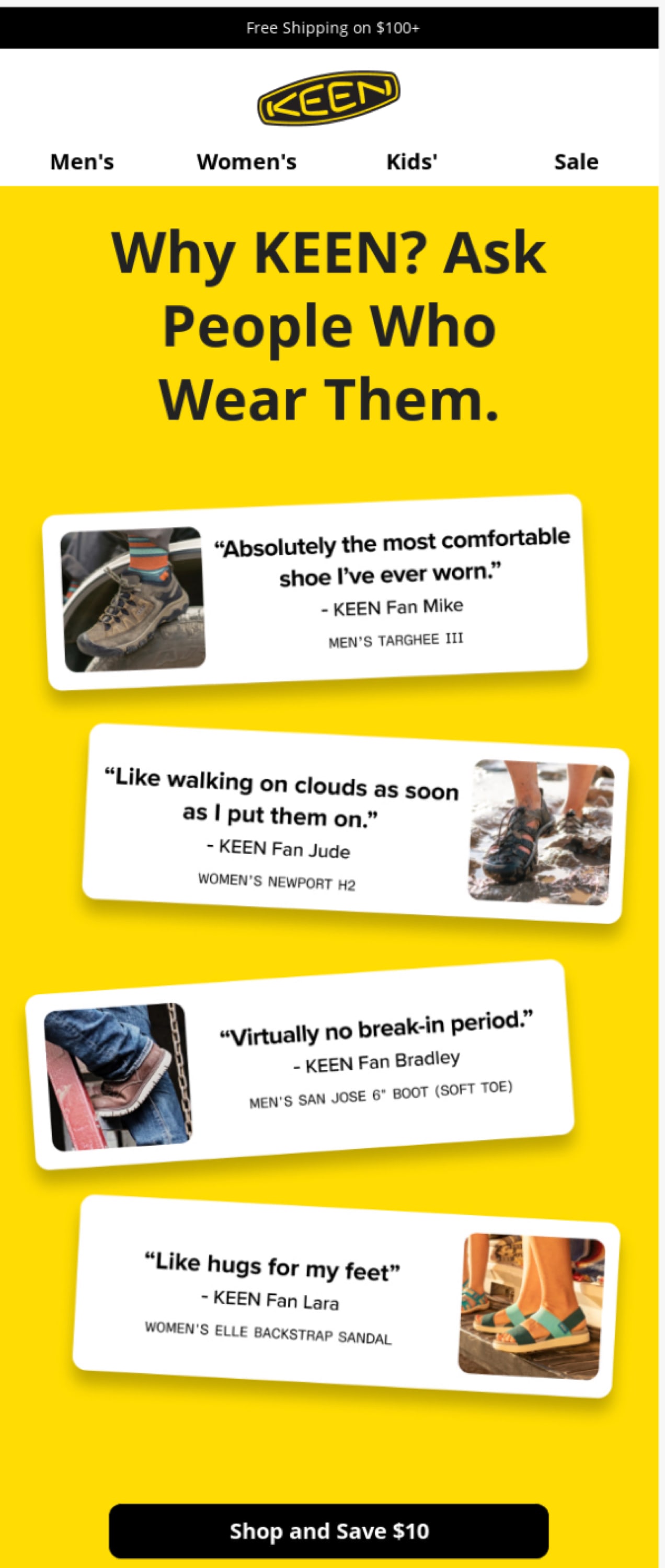
Survey emails
Surveys are a great way to engage and interact with customers, gather their opinions and feedback, and learn more about them so you can market more effectively.
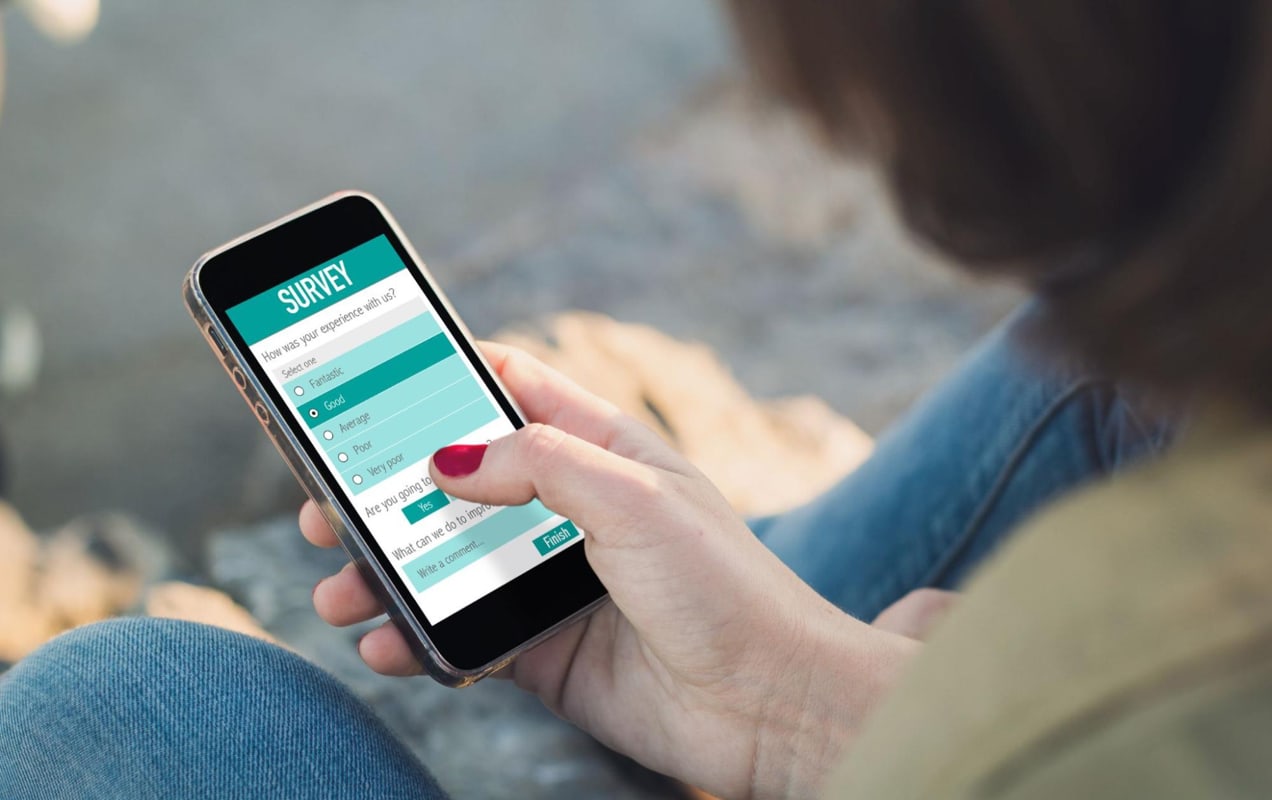
Surveys will get more participation if they take only a couple of minutes and have ten or fewer questions. And if you can give the survey a fun name, or make it seem very useful and value-driven, you’ll get more participation.
Entertaining emails
As you already saw, story and personality-driven emails can be entertaining. You can also attempt humor with memes, funny quotes, corny jokes that your audience will connect with, and whatever else makes you smile.
And when you combine some entertainment value with a few tips about something useful to your target audience, you have the makings of a great nurturing email to add to your marketing funnel.
But entertaining emails can also include links to videos, web pages, or social posts.
And you can get more creative than that.
Have your employee of the month do a crazy stunt, and film it. Ask AI to explain something and then make fun of the inaccuracies (or feign terror if it does a better job than you could). Have a different employee each month give a sincere greeting so people get to know the faces and people at your company.
There are many forms of entertainment. Find what’s appropriate for your email subscribers and
customers, and make this type of email part of your ongoing email strategy.
Interactive emails
Use quizzes and polls as fun ways to get people to participate with your content. The stakes can be low. The point here is to engage them and stay on their minds for a positive reason.
Interactivity can also mean asking subscribers to reply directly. For example, you could send an email asking people to share their favorite thing about a specific holiday.
You can also interact over social media, using email as the springboard. For example, take a screenshot of an Instagram post and put it in an email. Ask your subscribers to visit your post and like or comment on it.
Promotional email ideas
Sometimes it’s okay to be directly promotional. These kinds of messages should be part of a wider mix, however, that form a balanced approach to email marketing campaigns that will keep unsubscribe rates low while accomplishing your marketing goals.
You’ll also want to provide different ratios of promotional emails based on the audience segment. Previous customers or loyal followers may be more tolerant of these and are likely closer to converting anyways.
Pro tip: Remember, segmenting your audience is a way to multiply your email marketing ideas. Some sales emails will be appropriate for your entire email list. But others will only be relevant for portions of it. You’ll come up with more ideas for email campaigns when you start thinking in terms of segments, as opposed to your entire email list at once.
Here are some promotional emails you can try in order to increase revenue:
Membership emails
If you have any sort of recurring revenue or rewards program, you can use email to promote it.
Regularly including membership-promoting emails in your mix can normalize the idea of joining.
By hearing about it consistently, subscribers will accept the idea that it’s normal to take this next step, and that they’re actually holding back by not doing it.
As mentioned earlier, social proof emails can be very effective here.
By offering occasional special deals to join, such as the first month free, or a free gift for new members, you’ll really move the needle.
Here’s an email from Pink Lily that promotes their rewards program and also offers a referral bonus for happy customers.
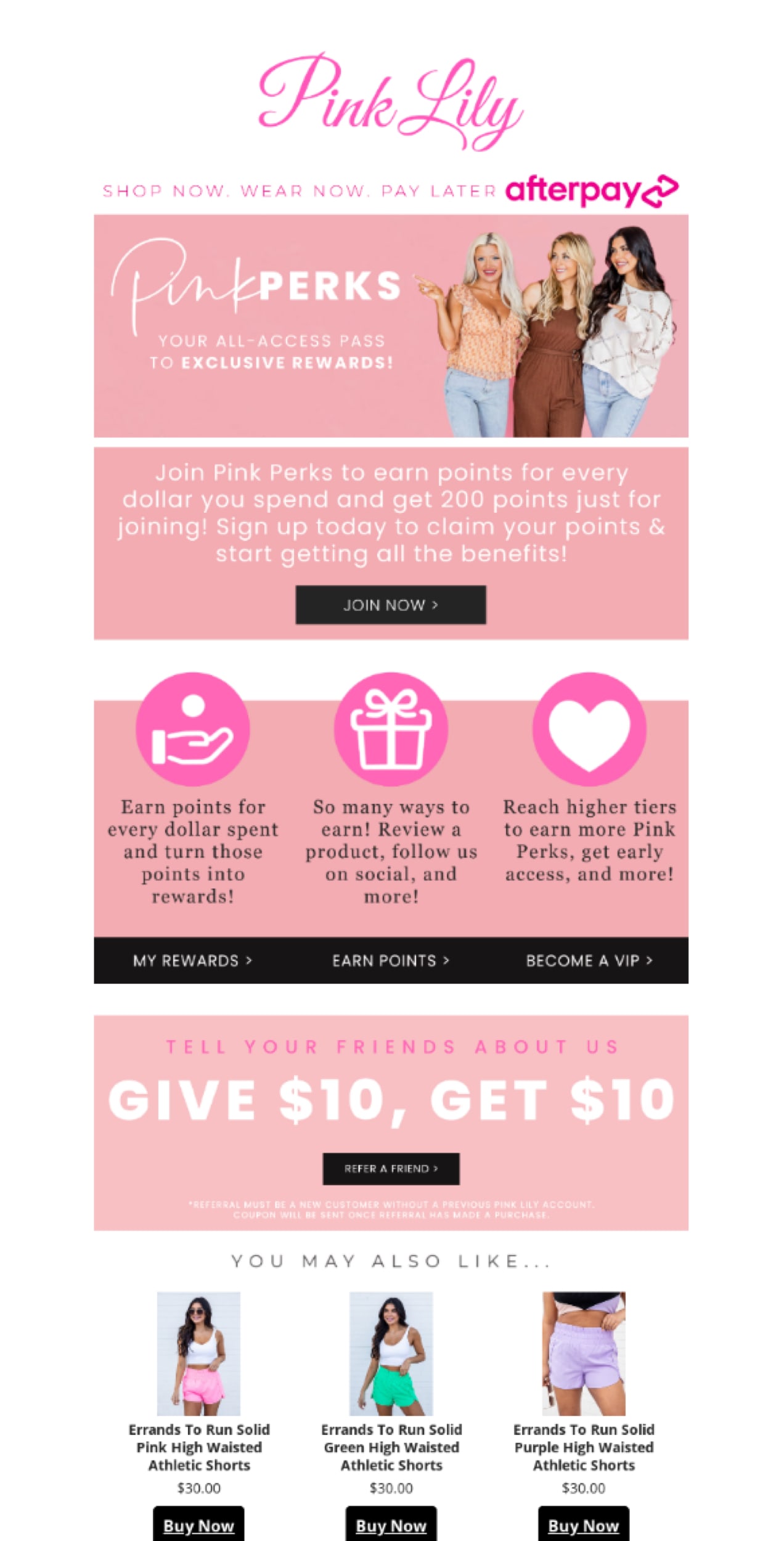
Coupons and discounts
Instead of offering discounts for no discernable reason, your sales will be more effective if you can tie them to a specific event or reason. Plus, this prevents you from getting into a never-ending sales cycle where customers constantly expect some sort of a discount.
Here are some situations where you can justify a discount without creating an expectation of permanence:
- Seasonal holidays
- Personalized deals like birthdays and anniversaries, including first purchase anniversaries
- A brand new product release
- Beta testing a new product or service
- An inventory clearout
- A back to school sale
- A graduation
- A housewarming
- A new customer promotion
Just keep in mind that email subscribers have already opted in to receive emails from you. That means that you’ve already won them over on some level. They liked something they saw or heard about you.
So you likely don’t need to send them tons of discounts to keep their business. But at the same time, sending an occasional flash sale acts as a sort of reward for being an email subscriber. This is more effective if you make it clear that only email subscribers are getting the deal.
And you can justify the internal costs of offering a discount because you don’t have to create any print marketing assets or pay for expensive online or offline ads.
So if you would normally spend $X on online ads promoting a product, you can justify a discount on that same product to your email contacts because you don’t have to pay for the online ads to convert them.
The best email discounts use unique links or coupon codes, which allow you to track the number of people who respond to your offer. This makes it easy to determine the ROI associated with the campaign.
Here’s a Labor Day holiday email from Jane, where the discount comes in the form of rewards points rather than money off. This is a way to use discounts that incentivize a future purchase.
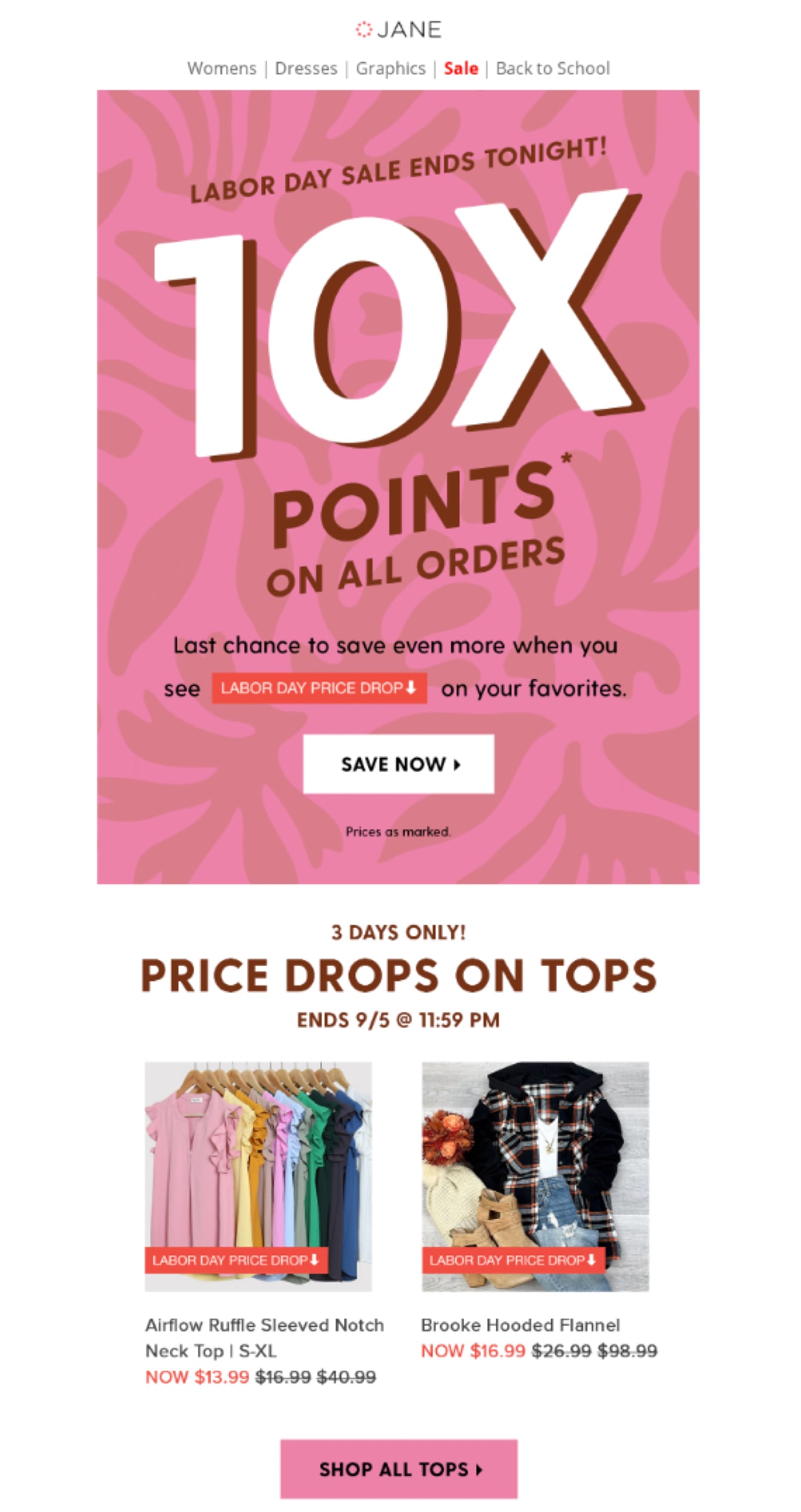
New product or service launches
In marketing, anything new is good. Especially when that new thing is something that your customers and subscribers want. This could be a new product category, service, rewards program, book, online portal, how-to guide, website, location — anything new is worth writing about in your emails.
With promotions-based email campaigns, your goal is to encourage customers to buy, so be sure to include trackable codes, link to dedicated landing pages and product pages, and deliver a seamless and enjoyable checkout experience.
Product emails should include photos of the item, or videos or photos showing customers or employees using it.
And new product announcements should be a series, rather than one single email. Why did you create or start selling this product? What need does it address? Why choose this brand over other brands? When will it be available? What’s so good about it?
And you can do the same thing for existing products. Pick items you want to feature and create email campaigns around them.
Here’s an email from City Chic announcing a new clothing collection. They include several photos of the new line, followed by a deal that offers 50% off when customers spend over $150.
This is another way to offer a discount but still ensure a profit margin by increasing the order size. Notice how the word “new” is sprinkled throughout the email.
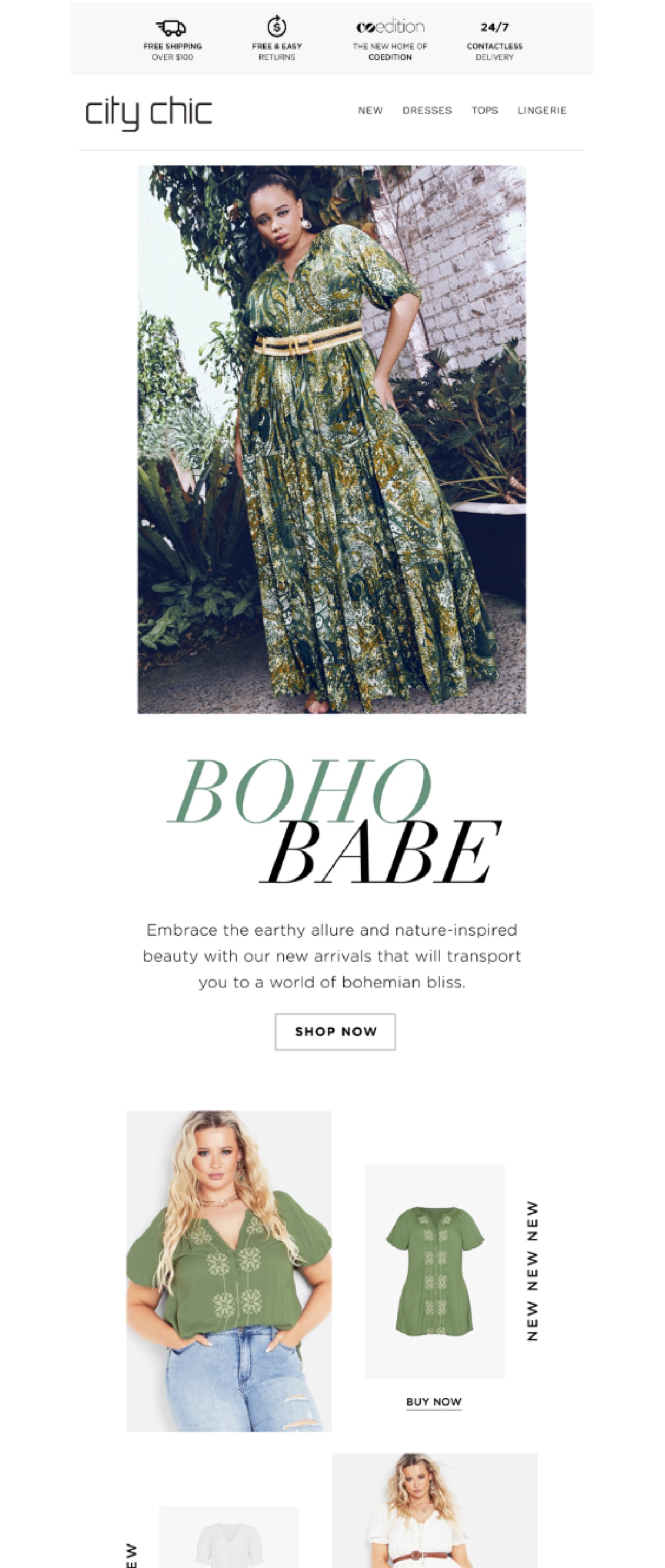
Referral program emails
Another way to generate more business is to create a campaign for your referral program. This can be a single email, but generally works better if you revisit the topic regularly. Not too often, but often enough that you’ll help customers feel like it’s a regular occurance to refer others to you.
If your referral program includes rewards, remind subscribers of what they earn when they refer new customers to you. Use it in your email subject lines about this topic.
The other thing you can do is make your referral emails educational and promotional, all at the same time. You could frame it like this:
Want to make a few bucks while referring your friends to our business? Here’s what to tell them.
Then, you might go on to explain how to “sell” your products or services to other people. But in the process of doing this, you’re also re-selling your value proposition to the people reading the email, giving them a fresh presentation of why they should continue to be loyal customers.
This promotes your business to the readers, educates them on why you’re so valuable and wonderful, and gives them a set of practical tools they can use to refer others to your business.
Automated email ideas
↑ Torna in cimaIn most situations, you won’t send automated emails to all of your existing customers or subscribers at once. So if you’re looking for email marketing ideas to send to your entire current contact list, automated emails probably won’t do the trick.
But if you’re looking to expand your email marketing program to engage people and keep them subscribed longer, spend some time developing email automation. The good news is, most email automation is evergreen, so once it’s done, you can set it and forget it.
Here are a few common types of automated emails to focus on:
Welcome emails
What happens after someone joins your list?
The best case scenario is that they feel welcomed, valued, and informed within a few days of joining. You can do all of this in a single welcome email, though it might get a bit long. Or, you can add a follow-up marketing email or two in the form of a welcome series.
Either way, these emails go out automatically to new subscribers.
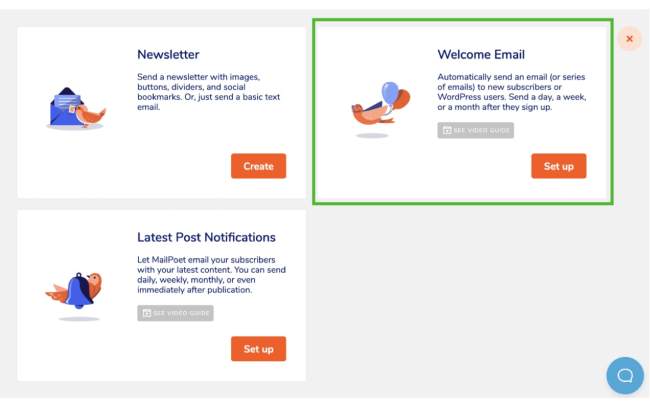
If your opt-in process promises a discount or other reward for signing up, the first email in the welcome series should include whatever coupon code they need to claim their reward. You may also want to introduce them to your products and services, share a bit about your company, encourage subscribers to join your community, and provide some entertainment.
In other words, make them glad they joined.
Here’s a great example of a welcome email from Express. It begins with enthusiasm and excitement, followed by a call to action with the promised discount and a trackable coupon code. Then it concludes with some of the key benefits of their customer loyalty program.
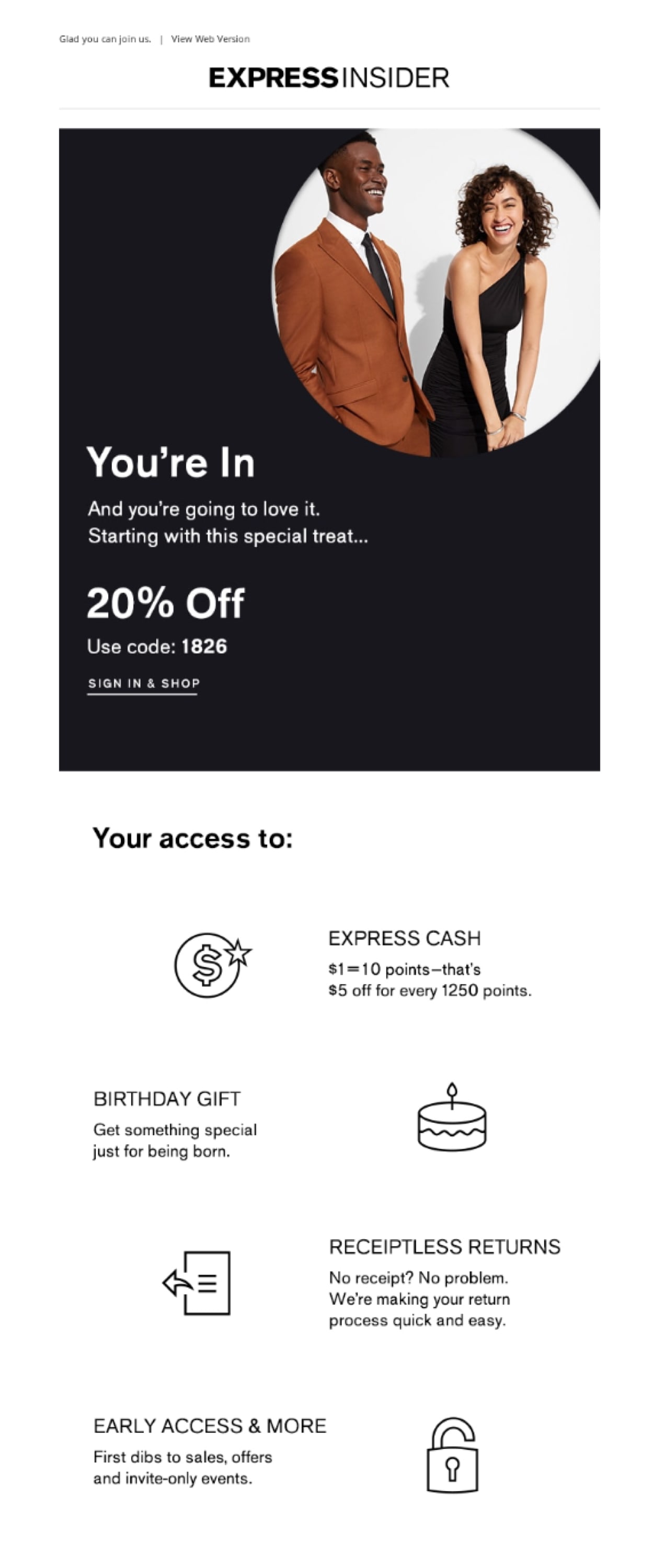
Winback emails
A winback email is an automated campaign you can set to go out once or twice a year, to all of your subscribers who haven’t opened or clicked on any emails in a certain amount of time. That could be six months, a year, or perhaps longer. Whatever length of time you decide, you can create a winback email campaign that gives your lapsed subscribers a chance to re-engage and remain subscribed.
For some email lists, this can include a sizable number of subscribers.
You’ll want to offer them some kind of incentive for remaining subscribed, like a special one-time coupon, free gift, contest, or other special opportunity. The idea here is to capture any remaining revenue that might be there from people who have just stopped engaging. You can also give them the option of unsubscribing.
Some of these people have moved on, and you’ll never hear from them again. And that’s fine — you want an engaged email list. For subscribers who ignore your winback campaign, you can safely drop them from your email list so you stop sending to unresponsive email addresses. Doing this can hurt your email deliverability and increase the chances your emails end up in the spam folder.
A winback campaign is ideally several emails long to be sure everyone sees at least one of them.
Here’s a winback email from Martha & Marley Spoon, created to encourage customers to try their meal kits again, and it includes a discount on the next two meals. The idea there is to set a pattern by repeating the purchases, since their business operates on a subscription model.
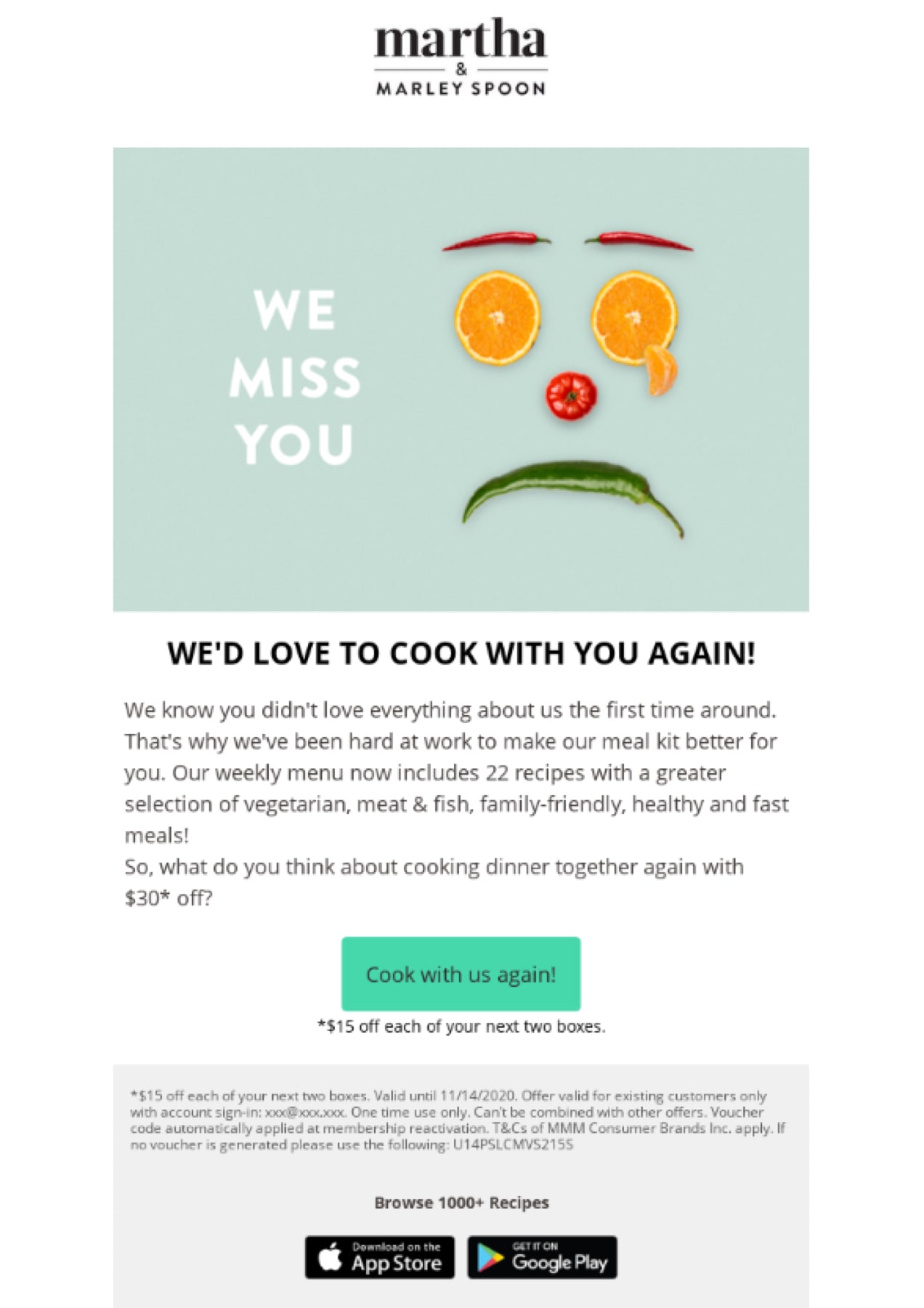
Abandoned cart emails
An abandoned cart email is a simple reminder email to encourage customers to complete a purchase they already started.
More than half of online shoppers place items in shopping carts but don’t ever complete their purchase. If you can remind these shoppers about their unpurchased items, and convince even a small handful of them to complete their purchase, you’ll earn revenue you would have otherwise lost.
Here’s a great example of an effective abandoned cart email from Pure. It features the product that’s still in the customer’s cart and a clear message indicating that this email is specifically for them.
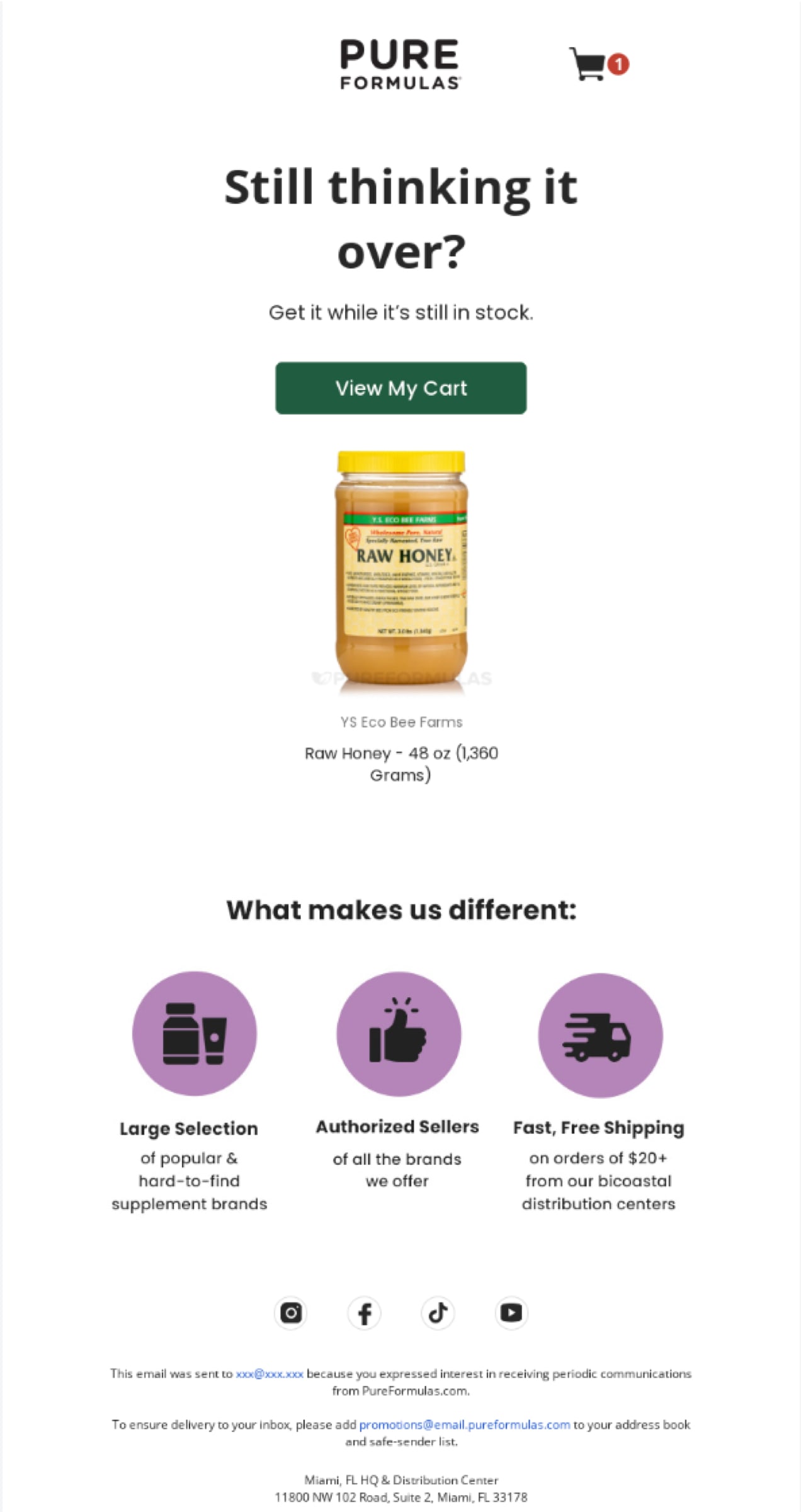
Thank you emails
When customers buy something from you, they should receive a thank you email that confirms their purchase and expresses your sincere appreciation for their business.
Make them happy about buying from you.
This sort of automation should be triggered not just after purchases, but after almost anything the customer or subscriber does that costs them something, including time. So anyone who fills out a survey should be thanked with an email, because you’re asking them to spend a few minutes that they could spend on other things.
New rewards member? Thank them. A customer refers a friend? Thank them. Someone requests free content like an ebook or guide? Thank them and re-state the benefits of whatever they asked for.
Here’s a simple thank you email from Shinola Detroit. It also doubles as an order confirmation, but, unlike most of those, it begins with a sincere “thank you” in a large font, then follows up with all the purchase details.
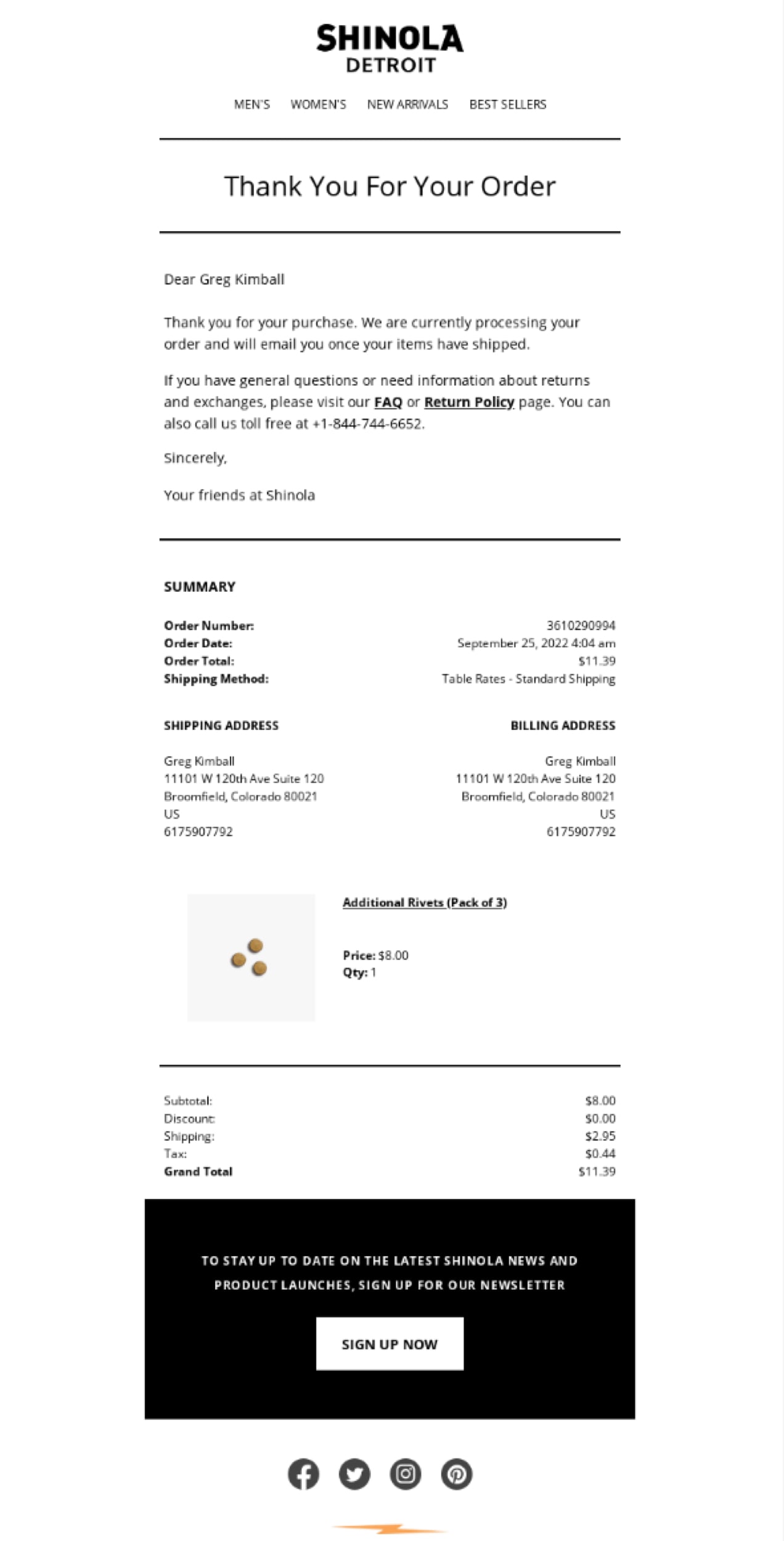
Membership renewal emails
Lastly, if you have a membership program and want to reduce churn, you want to create automated emails that will go out when their membership is about to expire. This applies primarily to annual memberships. If the membership is indefinite, you can simply send an email confirming that they’re about to pay for another period.
But this is also why you need to send ongoing content re-affirming the great and irreplaceable value of being a member, so more people continue paying for longer.
Membership renewal also applies to situations where a credit card is about to expire, and you need them to go in and update their information.
Here’s an email newsletter from Posh Peanut, offering access to their members rewards program.
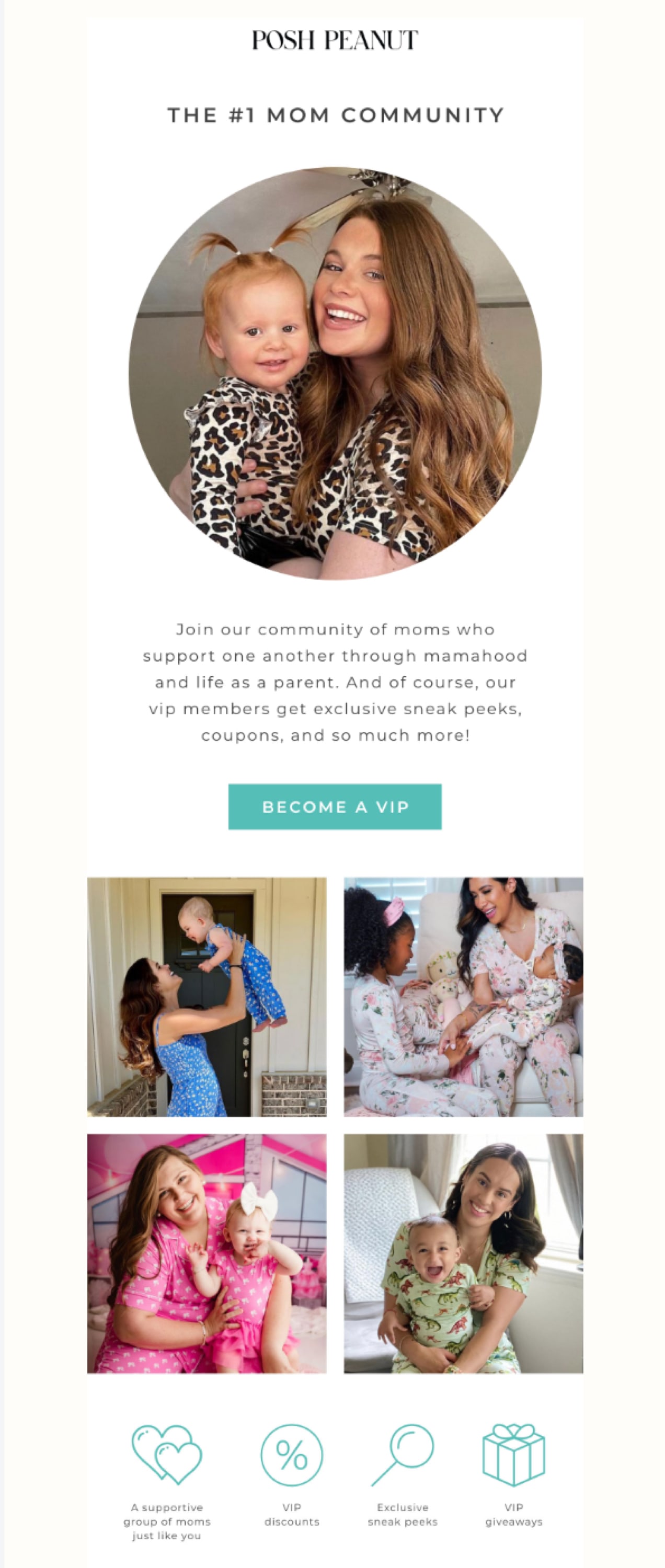
Upgrade your email marketing strategy
↑ Torna in cimaYou now have a clear three-step process for generating email marketing campaign ideas.
First, clarify the business goal, objective, or priority you want to address in your campaign.
Second, identify the marketing strategies you want to use to pursue that goal.
Finally, choose the types of emails you’ll need to write to implement that campaign, and create them.
Some of these ideas need ongoing attention, such as membership nurturing emails. Others come and go for set periods of time.
By using all of these strategies over time, you’ll develop a sophisticated and satisfying email marketing program that your customers and subscribers will appreciate and engage with. They’ll feel good, and your business will keep growing.
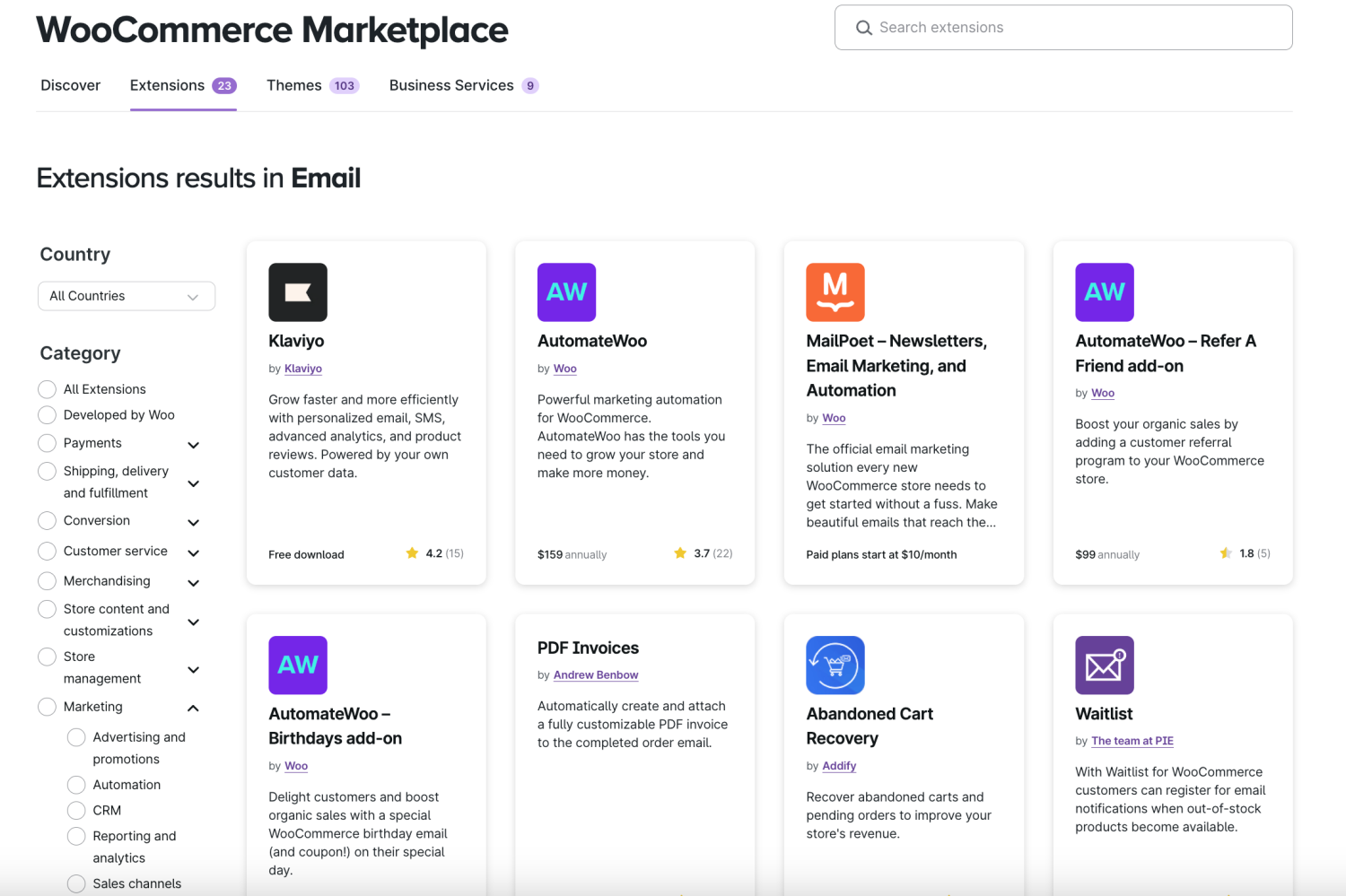
Ready to execute an effective email marketing campaign? WooCommerce integrates with all the tools you’ll need, like Klaviyo, MailPoet, and AutomateWoo. Create beautiful emails without having to edit code. Build successful emails and email series without needing to be a professional email marketer. Target specific segments of your audience. Launch campaigns faster with proven email templates. And track all of your work with powerful analytics tools.
See all of our email marketing extensions.
About


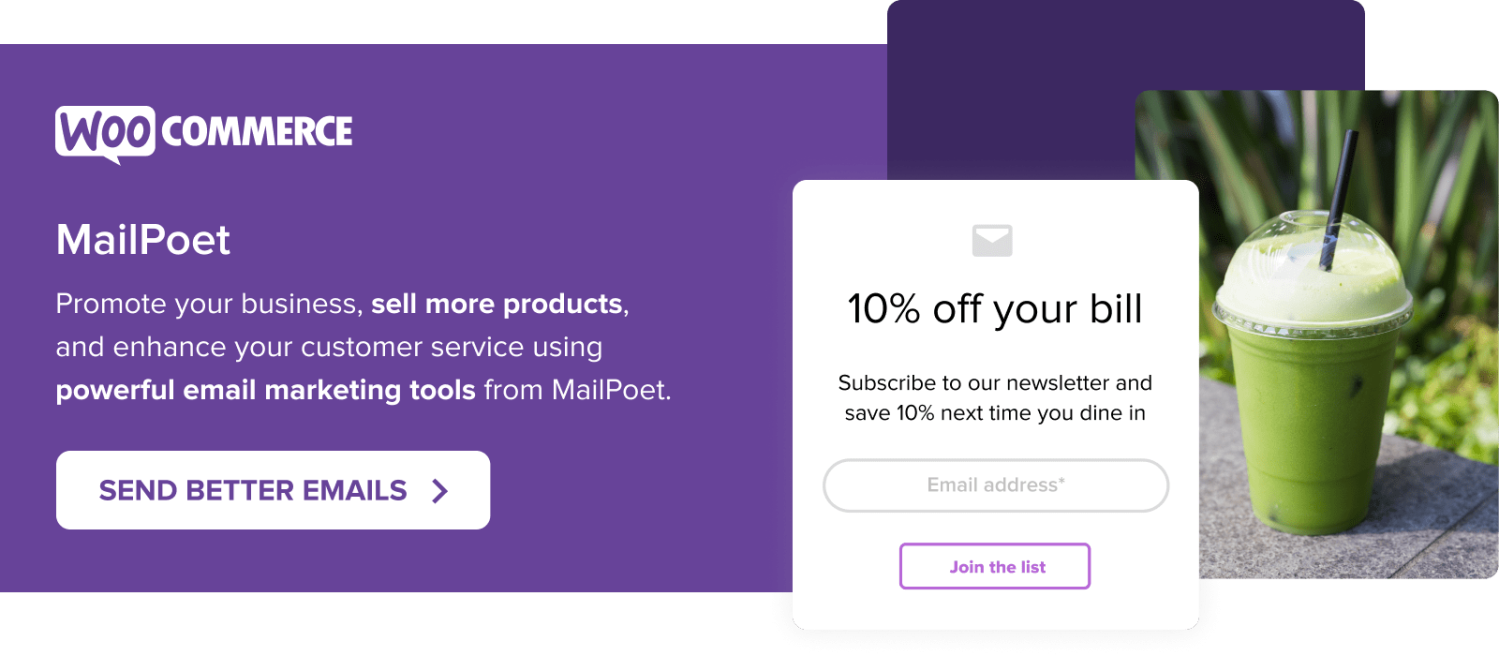



Wonderful
Thanks for reading, Wendell!